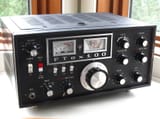Search Results
6/28/2025, 7:45:41 AM
>>2927044
Congrats on getting your licence.
Don't overthink your first radio set up, just figure how to get on the air. Trust me, it will grow from there. If you really got bit by the radio bug you'll end up with a room full of equipment like that guy in the meme the punks keep posting here. :^)
I worked days so I knew most of my operating would be at night so I concentrated on the lower HF bands. A couple of locals ragchew on 80m and encouraged me to start there. I'd done some monitoring with a Panasonic RF2200 and liked what I heard. One member gifted me his 80m vertical, another loaned me his old Yaesu FTdx100 like one pictured. Voila, I was on the air. After that it started to grow. I started experimenting with the vertical and laboriously found that tapping into certain parts of the loading coil I could use it on the lower SSB portion of the 40m band. My best DX is on 40m. I later put up a scrapped G5RV dipole that I repaired and used a coax switch to select the dipole or vertical.
>But it seems to me that not just the antenna but the whole setup is tuned for a very specific frequency
You're partially correct. An antenna can be made to work well on one wavelength and be multi-band with the addition of traps. Effective bandwidths on each band can be narrow but an antenna tuner will allow you to expand on it with reasonable performance but there are trade-offs with radiated efficency.
>And within a single band, do you get an antenna tuned for the middle frequency of the band and accept that performance won't be as good on the edges of the band?
Yes.
>Do you have a separate antenna for 10m, 2m, 70cm, etc and keep changing between them?
I used to when I had a dualband HT. My secondary radio has 4 separate outputs for HF/6m/2m/70cm. Changing bands on the radio changes the antenna. I run mostly SSB on VHF/UHF. My main HF radio has a separate output for HF and one for 6m.
>Everything is a compromise
What >2927048 said sums it up.
Congrats on getting your licence.
Don't overthink your first radio set up, just figure how to get on the air. Trust me, it will grow from there. If you really got bit by the radio bug you'll end up with a room full of equipment like that guy in the meme the punks keep posting here. :^)
I worked days so I knew most of my operating would be at night so I concentrated on the lower HF bands. A couple of locals ragchew on 80m and encouraged me to start there. I'd done some monitoring with a Panasonic RF2200 and liked what I heard. One member gifted me his 80m vertical, another loaned me his old Yaesu FTdx100 like one pictured. Voila, I was on the air. After that it started to grow. I started experimenting with the vertical and laboriously found that tapping into certain parts of the loading coil I could use it on the lower SSB portion of the 40m band. My best DX is on 40m. I later put up a scrapped G5RV dipole that I repaired and used a coax switch to select the dipole or vertical.
>But it seems to me that not just the antenna but the whole setup is tuned for a very specific frequency
You're partially correct. An antenna can be made to work well on one wavelength and be multi-band with the addition of traps. Effective bandwidths on each band can be narrow but an antenna tuner will allow you to expand on it with reasonable performance but there are trade-offs with radiated efficency.
>And within a single band, do you get an antenna tuned for the middle frequency of the band and accept that performance won't be as good on the edges of the band?
Yes.
>Do you have a separate antenna for 10m, 2m, 70cm, etc and keep changing between them?
I used to when I had a dualband HT. My secondary radio has 4 separate outputs for HF/6m/2m/70cm. Changing bands on the radio changes the antenna. I run mostly SSB on VHF/UHF. My main HF radio has a separate output for HF and one for 6m.
>Everything is a compromise
What >2927048 said sums it up.
Page 1
